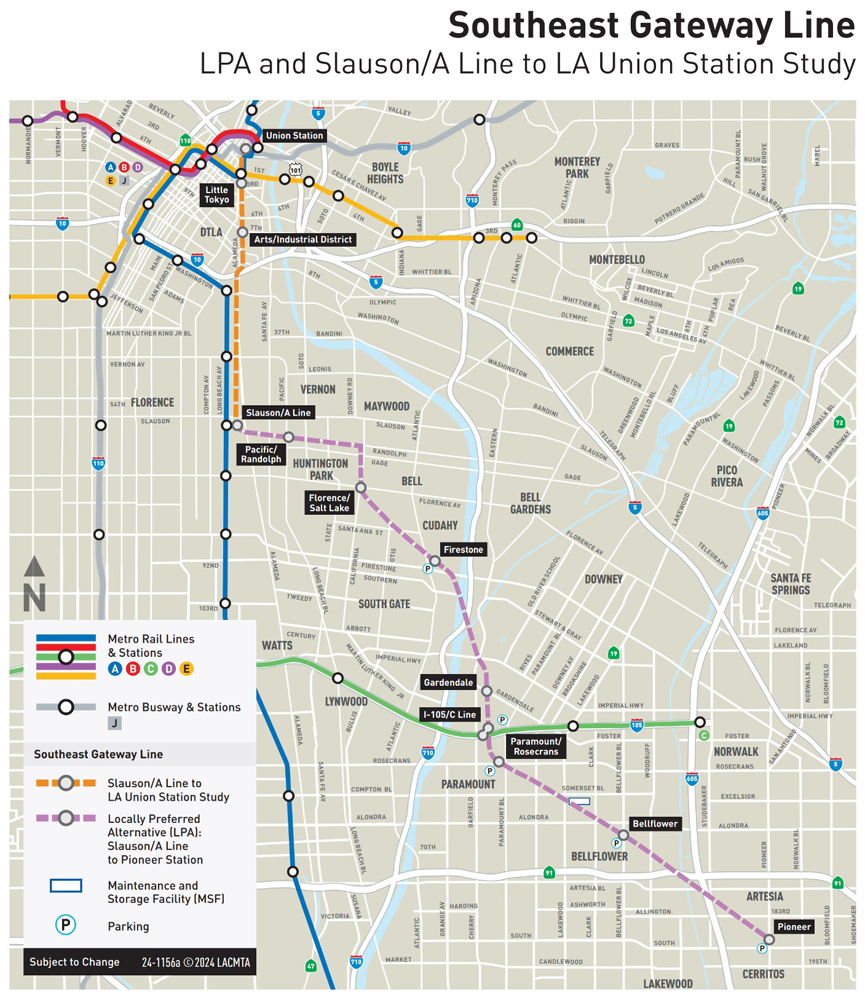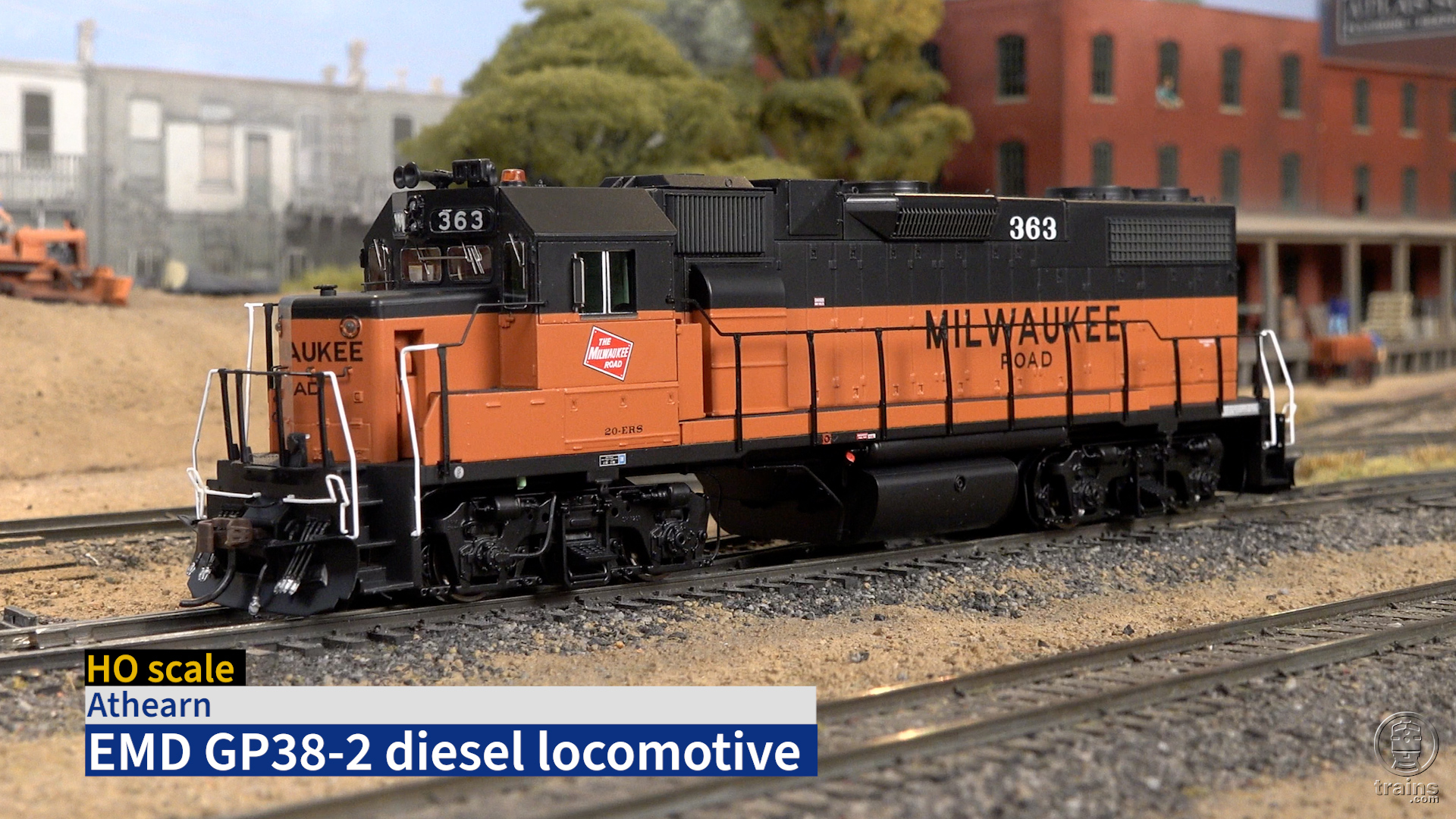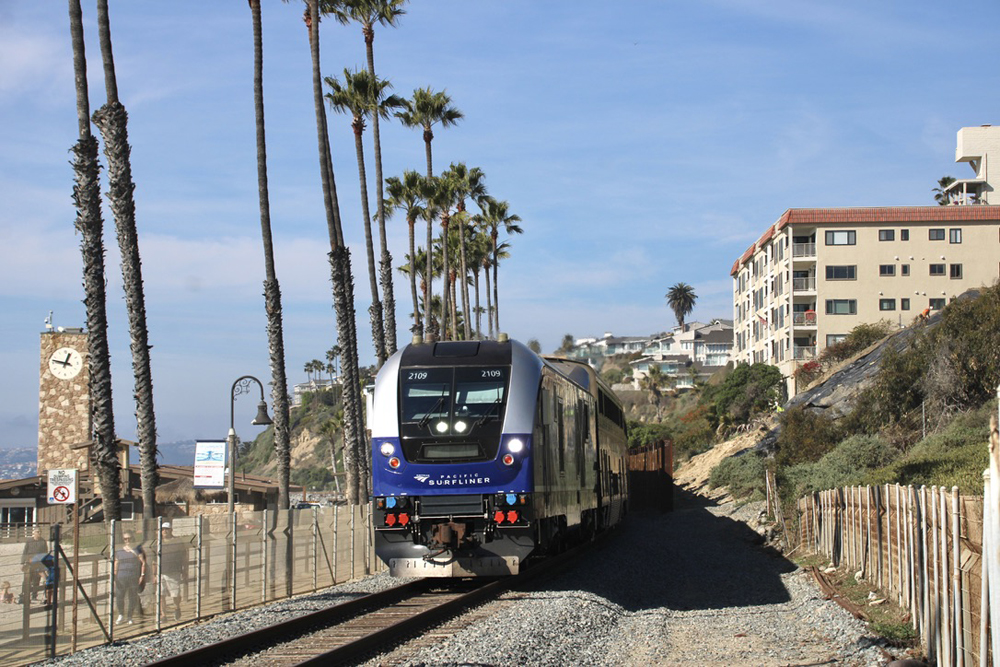
SACRAMENTO — Eleven rail projects, including a new LA Metro light rail line and extension of service in Sonoma County by SMART commuter trail, have received more than $850 million in funding from the Calfiornia State Transportation Agency (CalSTA) in awards announced last week.
“From new zero-emissions buses in the Central Valley to vital rail projects in Orange County, we’re building a better transit system to benefit all Californians,” Gov. Gavin Newsom said in announcing a total of more than $1.3 billion in awards for 27 projects. Those funds leverage more than $8.6 billion in matching federal, local, and other state funding.
Rail-centered projects receiving funding include:
— $231 million to LA Metro for the Southeast Gateway Line light rail project, previously known as the West Santa Ana Branch Corridor. The project will involve a new 14.5-mile, 10-station light rail line connecting to the existing Slauson A Line station, as well as an infill station to provide a connection to the C Line. More on the project is available here.
— $130 million to the San Francisco Municipal Transportation Agency for phase 2 of its Tran Control Upgrade program. The installation of communications-based train control also includes the upgrades that will allow Muni to retire the system in the Market Street Subway that relies on obsolete 5¼-inch floppy disks. The Muni board has approved a $212 million contract with Hitachi Rail for that upgrade [see “San Francisco Muni to replace floppy-disk …,” Trains News Wire, Oct. 21, 2024].

— $125 million to the Orange County Transportation Authority to improve resiliency at four locations in a 7-mile stretch of the LOSSAN Corridor in the San Clemente area, where slides have significantly disrupted rail operations in recent years. Work will include installation of 2- to 6-ton rocks, addition of sand to bolster the coastline, extension of an existing catchment wall, and engineered rock revetment.
— $81 million to Sonoma-Marin Rail Transit District for rebuilding an existing rail line in two segments totaling 8.8 miles, allowing SMART commuter rail service to be extended north to Healdsburg. Funding will also support an adjacent bike and pedestrian path.
— $70.9 million to the San Joaquin Regional Rail Commission and San Joaquin Joint Powers Authority for four rail projects: the Stockton Diamond grade separation project; the Stockton Wye project, which improves rail access in the northwest quadrant of the diamond; the Madera high speed rail station, which just received a federal Mega grant of more than $54 million [see “Chicago CREATE project receives …,” News Wire, Oct. 21, 2024]; and The Rail Academy of Central California (TRACC) Workforce Development Program, to be taught at the SJRRC Regional Maintenance Facility in Stockton.
— $63.3 million to the Coast Rail Coordinating Council, a coalition of five regional government associations, for three projects between Monterey and Santa Barbara counties. They include the King City Multi Modal Transportation Center, a new station in the Monterey County community of King City to be used by the Coast Starlight and bus service; crossover and siding improvements near San Luis Obispo and Paso Robles to improve operations related to a new maintenance facility to be constructed in San Luis Obispo; and the Ortega siding, between Santa Barbara and Carpinteria, which will allow a seventh Pacific Surfliner round trip between Goleta and San Diego.
— $44.8 million to the Southern California Regional Rail Authority, parent of Metrolink, for design and construction of the Eastern Maintenance Facility in Colton. The construction of two service and inspection tracks will allow two additional round trips on Metrolink’s Inland Empire-Orange County Line and two on the San Bernardino Line.
— $40.5 million to the Riverside County Transportation Commission for a new Metrolink Station at Mead Valley between the existing Moreno Valley/March Field and Perris-Downtown stations on the 91/Perris Valley Line. The design includes platforms for a future double-track alignment, a bus loop, and rideshare parking.
— $38.5 million to the North County Transit District and San Diego Association of Government for two projects on the LOSSAN Corridor in San Diego County: double-tracking of a 0.6-mile segment of single track between Eastbrook and Shell, just north of the Oceanside station, and further stabilization of the Del Mar bluffs. Double-tracking of the Eastbrook-Shell segment will create 10.3 miles of continuous double track. The bluffs project includes installation of up to 128 additional soldier piles to reduce the risk of slope failure.
— $29 million to Sacramento Regional Transit for light-rail system improvements including the purchase of six new low-floor trainsets, modernization of 17 stations, and construction of two new stations: Dos Rios on the Blue line in Sacramento’s River District, and Horn Road on the Gold Line in Rancho Cordova.
— $14 million to the Capitol Corridor Joint Powers Authority and the City of Sacramento for three projects impacting Capitol Corridor Amtrak service, Altamont Corridor Express commuter trains, and SacRT transit. Those projects include the Santa Clara interlocking project, which will add a crossover north of the Santa Clara-University station to address congestion in an area used by Capitol Corridor, ACE, Caltrain, Amtrak’s Coast Starlight, and freight trains; and the Agnew Siding, which will build 2,900 feet of new track with power switches near the Santa Clara-Great America station, providing the ability to offer more special-event service. The third project involves street and bike-path connection to the Sacramento Valley station in Sacramento used by Capitol Corridor, San Joaquin, and Sacramento light-rail trains.
Bay Area Rapid Transit also received a $25 million award for a transit-oriented development project to include 739 residential units in North Berkeley.
The full list of projects, with more details on each, is available here.














SMART has only ever planned to provide service as far as Cloverdale. But Healdsburg was always planned to be first.
That line to Healdsburg is in marginal shape. All the signals are de-energized and turned, the crossing gates removed. Grass and weeds in the ROW, so bad you can’t even see ballast in places.
It gets worse the farther north you go.
But I like the fact SMART is moving its way north. They got the trail people to settle down and agree on placement next to the ROW, which is how it is up in Ukiah. If Healdsburg can get some TOD going in their downtown, this would be a great place to work.